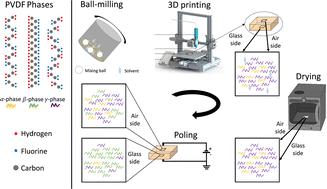Our official English website, www.x-mol.net, welcomes your
feedback! (Note: you will need to create a separate account there.)
释放 PVDF 的压电潜力:通过热接触极化从 γ (γ) 相转变为 β (β) 相的研究
RSC Advances ( IF 3.9 ) Pub Date : 2023-10-25 , DOI: 10.1039/d3ra05068h Alban Morali 1 , Arijit Mandal 1 , Maksim Skorobogatiy 2 , Sampada Bodkhe 1
Affiliation

|
聚偏二氟乙烯 (PVDF) 以其压电特性而闻名。这种材料具有不同的晶相,α (α)、β (β) 和 γ (γ),其中 β 相尤其与 PVDF 的压电行为有关。虽然 PVDF 中从 α 相到 β 相的转变有据可查并得到广泛研究,但从 γ 相到 β 相的转变尚未得到充分探索。然而,当 PVDF 通过某些基于溶液的方法生产时,它可以采用其γ形式,它不像 β 相那样压电。因此,本研究旨在通过研究通过基于溶液的技术获得的 PVDF 纳米复合材料薄膜从γ相到β相的转变来弥合这一差距。我们的 PVDF 纳米复合材料是通过溶剂蒸发辅助 3D 打印 PVDF 纳米复合材料与钛酸钡纳米颗粒 (BTO) 制成的。为了实现 γ 相到 β 相转变,我们首先强调退火在 PVDF 样品成功极化中的重要性。然后,我们使用傅里叶变换红外光谱 (FTIR)、X 射线衍射 (XRD) 和差示扫描量热法 (DSC) 对 PVDF-BTO 的α、β和γ晶体相进行深入分析。我们观察到,退火后但在极化之前,PVDF-BTO 纳米复合材料含有 76% 的 β + γ 相,其中大部分是 γ 相。对这些样品进行极化,β + γ 相的组合达到 93%,出现 β 相绝对分数的 40%。然后,我们证明了纳米复合材料中β相的分数——如 PVDF 的 FTIR 光谱中的 1275 cm-1 峰所示——在薄膜的表面积上并不均匀。 此外,绝对β相含量的值还取决于极化场的方向。我们的研究表明,在考虑 PVDF 的压电行为时,了解这些细微差别至关重要,本文提供了有关如何解决这些细微差别的重要见解。总体而言,本研究为增强基于 PVDF 的纳米复合材料的压电性传感应用提供了分步指南。

"点击查看英文标题和摘要"

































 京公网安备 11010802027423号
京公网安备 11010802027423号